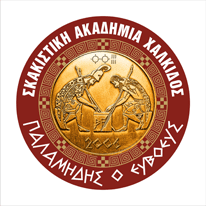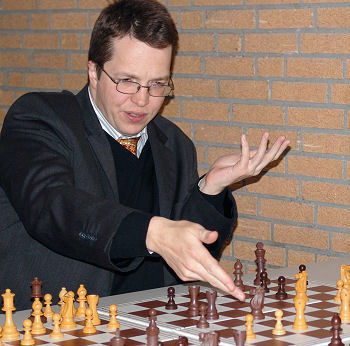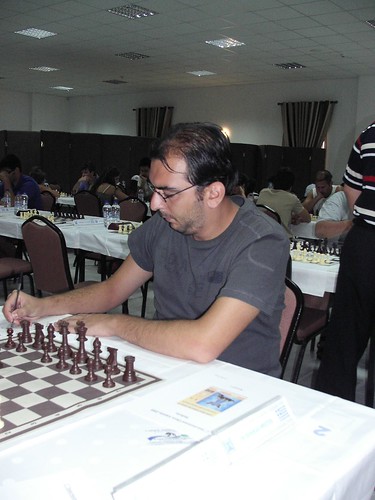| Latest | Greatest | Lobby | Journals | Search | Options | Help | Login |
|
|
|
This topic is archived. |
| Home » Discuss » Topic Forums » Sports |
|
| Jack Rabbit
|
Sun Aug-23-09 05:11 PM Original message |
| The JR Chess Report (August 23): Chuckie Takes Jermuk |
|
Chuckie wins Jermuk Grand Prix
 Ukraininan grandmaster Vassily Ivanchuk, known to his many, many fans as "Chuckie", scored 8� points in 13 rounds to take first place in the fifth leg of the FIDE Grand Prix completed just hours ago in the health resort Mecca of Jermuk, Armenia. Vassily Mikhailovich spent most of the tournament tied for the lead with Hungarian grandmaster Peter Leko and Rustam Kasimdzhanov of Uzbekistan. For Kasidzhanov, it was his most impressive finish in an elite grandmaster tournament since being prematurely raised to that level of competition by winning the 2003 FIDE Knock Out Tournament in Tripoli, Libya, the last Knock Out tournament on which FIDE foolishly insisted calling the winner world champion. When the final round started today, six out fourteen players still had a shot at winning or sharing first prize with Leko and Ivanchuk sharing the lead with 7� points each. Chuckie, playing Black, defeated Armenian GM Vladimir Akipian in 62 moves to assure himself at least a share of the tournament title, while Leko lost to Israeli GM Boris Gelfand in 78 moves. Gelfand, with 8 points, finshed tied with Armenia's Levon Aronian, who beat Russian GM Ernesto Inarkiev today. Leko, with 7� points, finished tied for fourth with Kasimdzhanov and former Russian national champion Evgeny Alekseev, both of whom played draws today. Old Timers Short, Timman and Korchnoi Shine in Staunton Memorial  Former world championship challenger Nigel Short, 44, rejoined the 2700 club after an absence of many years by scoring 8 points in ten rounds in the Scheveningen team match while Jan Timman, 57, also a former world title competitor, won the round robin competition in which Viktor Korchnoi, 78, who nearly won the world championship from Anatoly Karpov 31 years ago, finshed a strong third at the seventh annual Howard Stauton Tournament with finished in London at the historic chess haunt Simpson's Divan Monday. In the round robin event, Mh. Timman scored 7 points in nine rounds while Viktor Lvovich scored 6. Russian grandmaster Alexander Cherniaev was second with 6� points. Timman won 6 games and lost one, that to Viktor Lvovich. In the ten-round-by-five-board Scheveningen team match, the British players, led by Short, defeated a Dutch team led by national champion Jan Smeets, 26�-23�. Mr. Short's dominance in this event is demonstrated by the fact that the British team won with Mr. Short being its only player to score better than 50%. Viktor Lvovich Korchnoi was born in Leningrad, the once and future St. Petersburg, on March 23, 1931. He was in the world championship cycle by the late fifties and was four times Soviet Champion. In 1974, he narrowly lost the final candidates' match to Karpov, who went on to take the title when then-champion Bobby Fischer defaulted in a dispute with FIDE over conditions for the title match. Viktor Lvovich defected to the West in 1976, finally settling in Switzerland. Although still stateless in 1978, he won the right to challenge Karpov for the world title. The match was held in Baguio City in the Philippines and was won by Karpov, 6 wins to 5 with draws not counting, in 32 games. Korchnoi also played Karpov for the world title in 1981, but was soundly beaten by Karpov in a match held in Merano, Italy. Viktor Lvovich is considered one of the greatest players never to win the world championship. Since 1996, he has earned the reputation of being the greatest senior citizen player of all time. Keti Arakhamia-Grant Takes Baltic Queen Crown  Grandmaster Ketevan Arakahmia-Grant of Scotland by way of Georgia won the Baltic Queen Women's Tournament in St. Petersburg Thursday with 6 points in nine rounds. International master Ekaterina Atalik of Turkey by way of Russia, who led much of the way until faletering in the final rounds, finished second with 5� points. Grandmaster Pia Cramling of Sweeden, German IM ELisabeth P�htz and IM Viktorija Cmilyte of Lithuania tied for third with 5 points each. Ms. Arakhamia-Grant started the tournament badly, scoring only 1� points in the first four rounds. She then won her next four game, culminating with an eighth round win over Mrs. Atalik to secure the tournament title. Ms. Arakhamia-Grant became a full grandmaster earlier this year and switched her federation from her native Georgia to Scotland. She has lived in Edinburgh since her marriage to grandmaster Jonathan Grant in 1996. The couple have one child. Ms. Arakahmia-Grant was the overall Scottish national champion in 2003 and runner up in the British national championship in 2006. Four Share First Prize in Acropolis Open  Four players shared the top honors in the Acropolis Open completed Tuesday in Chalkida, about 30 miles from Athens. Borki Predojevic (Bosnia), Hristos Banikas (Greece), Ioannis Papaioannou (Greece) and Atanas Kolev (Bulgaria) scored 6� points each in nine rounds. Predojevich is first among equals with the superior tiebreak score. The tournament got off to a tragic start when Greek master Nikolaos Karapanos suffered a heart attack while planning his final moves against Dan Zoler of Israel in the first round. Zoler, a doctor, immediately jumped into action in an attempt to revive Karapanos, but to no avail. Karapanos was taken to a hospital where he was pronouced dead. Dr. Zoler, who was in a completely lost position, resigned the game and, understandably shaken, withdrew from the tournament. One hundred players started the event. Calendar Russia-China Team Match, SOchi 14-24 August. NH Experience-Rising Stars Team Match, Amsterdam 20-31 August. Greybeards: Beliavsky, Ljubojovic, Nielsen, Svidler, van Wely. Brats: Caruana, Hou Yifan, Nakamura, Smeets, Stellwagen. International Festival d'�checs, Montreal 27 August-7 September. Grandmaster Tournament will include Bacrot, Onischuk, Shulman, Naiditsch and Maze; more to be added. Grand Slam Final, Bilbao 2-15 September. Topalov, Karjakin, Grischuk and Shirov qualify. Topalov dropped and will be replaced by Aronian. Second Pearl Spring Tournament, Nanjing 27 September-9 October. Topalov, Anand, Carlsen, Radjabov, Jakovenko and Wang Yue. World Junior Championship, Mar del Plata (Argentina) 16-29 October. European Club Cup (Team Championship), Novi Sad (Serbia) 21-31 October. World Cup, Khanty Mansiysk 28 November-15 December. London Chess Classic 7-16 December. Corus Chess Tournament, Wijk aan Zee 15-31 January 2010. Nakamura has been invited to play in group A. Anand-Topalov Match for the World Title, Site TBA c. April 2010. Games will be posted later. |
| Printer Friendly | Permalink | | Top |
| Jack Rabbit
|
Sun Aug-23-09 09:02 PM Response to Original message |
| 1. This week's games |
|
Your humble hare acknowledges the assistance of Fritz 6.0 on analysis. Diagrams on the Jack Rabbit Chess Report are made with Chess M�rida, a true type font that can be downlaoded free here. !""""""""# $tMvWlVmT% $OoOoOoOo% $ + + + +% $+ + + + % $ + + + +% $+ + + + % $pPpPpPpP% $RnBqKbNr% /(((((((() WHITE White to move (This position is a theoretical draw) |
| Printer Friendly | Permalink | | Top |
| Jack Rabbit
|
Sun Aug-23-09 09:03 PM Response to Reply #1 |
| 2. FIDE Grand Prix, Jermuk |
| Printer Friendly | Permalink | | Top |
| Jack Rabbit
|
Sun Aug-23-09 09:04 PM Response to Reply #2 |
| 3. Jakovenko - Inarkiev, Round 11 |
|
Rather than provide an important game or two for Jermuk this week, my staff* and I have decided to provide one good game between two players who had no chance at first prize by the end of the tournament and provide some late-round games critical to the prizes next week.
 Ernesto Inarkiev Dmitry Jakovenko - Ernesto Inarkiev FIDE Grand Prix, Round 11 Jermuk, 21 August 2009 Spanish Grand Royal Game: Zaitsev Defense 1.e4 e5 2.Nf3 Nc6 3.Bb5 a6 4.Ba4 Nf6 5.0-0 Be7 6.Re1 b5 7.Bb3 d6 8.c3 0-0 9.h3 Re8 10.d4 Bb7 11.Nbd2 Bf8 12.Bc2
12...g6
13.d5 Nb8 14.b3 c6 15.c4 Nbd7 16.Nf1 Nb6!?
17.Rb1
17...Qc7 18.Ne3 c5
19.g4 h5 20.Kh1!?
20...Bg7
21.Rg1 hxg4 22.hxg4 Kf8
23.Rg3 Ke7 24.b4
24...cxb4 25.Rxb4 bxc4 26.Nxe5?!
!""""""""# $t+ +t+ +% $+vW LoV % $oM + Mo+% $+ +pN + % $ Ro+p+p+% $+ + N R % $p+b+ P +% $+ Bq+ +k% /(((((((() WHITE: Dmitry Jakovenko Position after 26.Nf3e5:p 26...Nxe4!
27.Nxg6+ Kd8
28.Bxe4 Rxe4 29.Qf3 Rd4?!
30.Rxb6 fxg6 31.Rb1 c3 32.Rh3?!
32...Qe7 33.Ba3?
!""""""""# $t+ L + +% $+v+ W V % $o+ O +o+% $+ +p+ + % $ + T +p+% $B + Nq+r% $p+ + P +% $+r+ + +k% /(((((((() WHITE: Dmitry Jakovenko Position after 33.Bc1a3 33...Kc7?
34.Ng2
34...Ra4 35.Rb3?
35...Rc8!?
36.Rh7 Kb8!
37.Bc1
37...Rxa2 38.Nf4 Ra1!
39.Kg2 Rxc1 40.Ne6 c2 41.Rxg7 !""""""""# $ Lt+ + +% $+v+ W R % $o+ On+o+% $+ +p+ + % $ + + +p+% $+r+ +q+ % $ +p+ Pk+% $+ R + + % /(((((((() WHITE: Dmitry Jakovenko Position after 41.Rh7g7:B 41...Qxg7!!
42.Nxg7 Rb1! 0-1
*Your humble hare would like to thank the staff of the JRCR: Buccaneer, Spitfire, Swashbuckler, Pancho and Robin Hood. |
| Printer Friendly | Permalink | | Top |
| Jack Rabbit
|
Sun Aug-23-09 09:06 PM Response to Reply #1 |
| 4. Howard Staunton Memorial Tournament, Simpson's Divan, London |
| Printer Friendly | Permalink | | Top |
| Jack Rabbit
|
Sun Aug-23-09 09:07 PM Response to Reply #4 |
| 5. van Wely - Shoirt, Team Match, Round 10 |
 Nigel Short Loek van Wely (Holland) - Nigel Short (Britain) Staunton Memorial Tournament (Scheveningen Match), Round 10 London, 17 August 2009 East India Game: Nimzo-Indian Defense (Capablanca Opening) 1.d4 e6 2.c4 Nf6 3.Nc3 Bb4 4.Qc2 d5
5.cxd5 Qxd5 6.e3
6...c5 7.a3
7...Bxc3+ 8.bxc3 0-0 9.Nf3 b6 10.c4 Qh5!?
11.Be2
11...Bb7 12.0-0 Nbd7 13.a4
13...Qg6!?
!""""""""# $t+ + Tl+% $Ov+m+oOo% $ O +oMw+% $+ O + + % $p+pP + +% $+ + Pn+ % $ +q+bPpP% $R B + + % /(((((((() WHITE: Loek van Wely Position after 13...Qh5g6 14.Qxg6!
14...hxg6 15.Bb2 a5 16.Rfd1 Rfd8
!""""""""# $t+ T +l+% $+v+m+oO % $ O +oMo+% $O O + + % $p+pP + +% $+ + Pn+ % $ B +vPpP% $R +r+ K % /(((((((() WHITE: Loek van Wely Position after 16...Rf8d8 17.Nd2!
17...Rac8 18.f3 cxd4 19.exd4
19...Ba6 20.Kf2 Rc7 21.Rac1 Rdc8
22.Ba3 Ne8 23.f4 Bb7 24.Re1
24...Bc6
25.Bd1
25...Ndf6 26.g4 Rd7 27.Ke3
27...Rcd8 28.Bb2 Nd6 29.h3 Rc8
30.Ba3
30...Bb7 31.Be2 Ba6
32.Bd3 Rc6 33.Rc2 Rdc7 34.Rec1 Rc8
35.Ke2
35...Kh8 36.Kd1 Nfe8
37.Ke2 Nf6 38.Ke3 Kg8 !""""""""# $ +t+ +l+% $+ + +oO % $vOtMoMo+% $O + + + % $p+pP Pp+% $B +bK +p% $ +rN + +% $+ R + + % /(((((((() WHITE: Loek van Wely Position after 38...Kh8g8 39.g5!
39...Nh5 40.d5!?
40...exd5 41.cxd5?
!""""""""# $ +t+ +l+% $+ + +oO % $vOtM +o+% $O +o+ Pm% $p+ + P +% $B +bK +p% $ +rN + +% $+ R + + % /(((((((() WHITE: Loek van Wely Position after 41.cd5:p 41...Rxc2! 42.Rxc2
42...Re8+ 43.Kd4 Bxd3 44.Rc6
44...Nf5+ 0-1
|
| Printer Friendly | Permalink | | Top |
| Jack Rabbit
|
Sun Aug-23-09 09:09 PM Response to Reply #4 |
| 6. Timman - Davies, Round Robin Group, Round 9 |
 Jan Timman Jan Timman - Nigel Davies Staunton Memorial Tournament (Round Robin Group), Round 9 London, 17 August 2009 Open Sicilian Game: Kan Defense 1.e4 c5 2.Nf3 e6 3.d4 cxd4 4.Nxd4 a6 5.Bd3
5...g6
6.0-0 Bg7 7.Be3 Ne7
8.c4 0-0 9.Nc3 d5
10.exd5 exd5 11.Re1
11...Nbc6!?
12.Nxc6
12...bxc6 13.Bc5 Be6 14.Qa4!?
14...Re8 15.Rad1 Qc7 16.h3
16...Qb7 17.Re2
17...dxc4 18.Bxc4 Bxc4 19.Qxc4 Nd5
20.Red2
20...Rad8 21.a4 Qc8
22.Nxd5 cxd5 23.Rxd5 Rxd5 24.Qxd5 Bxb2 25.Be3
25...h5
26.Rb1 Rd8 27.Qe4 Re8 28.Qb4
28...Be5 29.Rc1 Qd7 30.Qc4 Qb7 31.Qc6!?
31...Rb8!?
!""""""""# $ T + +l+% $+w+ +o+ % $o+q+ +o+% $+ + V +o% $p+ + + +% $+ + B +p% $ + + Pp+% $+ R + K % /(((((((() WHITE: Jan Timman Position after 31...Re8b8 32.Kf1!?
32...Kg7 33.Qxb7
33...Rxb7 34.Rc6!
34...a5 35.Rc5!?
35...Bc7 36.Ke2 Kf6 37.Rb5!?
37...Rxb5 38.axb5 Ke6 39.Kd3 Kd5?
!""""""""# $ + + + +% $+ V +o+ % $ + + +o+% $Op+l+ +o% $ + + + +% $+ +kB +p% $ + + Pp+% $+ + + + % /(((((((() WHITE: Jan Timman Position after 39...Ke6d5 40.Kc3!
40...f5 41.Kb3 f4 42.Ba7
42...Bd6 43.Ka4 Bb4 44.Bb6 Ke4
45.f3+ Kd3
46.Bc7 Bc5 47.Kxa5 Ke2 48.Bxf4 Kf2 !""""""""# $ + + + +% $+ + + + % $ + + +o+% $KpV + +o% $ + + B +% $+ + +p+p% $ + + Lp+% $+ + + + % /(((((((() WHITE: Jan Timman Position after 48...Ke2f2 49.b6!
49...Bxb6+
50.Kxb6 h4 51.Bg5!
51...Kxg2
52.Bxh4 g5 53.Bxg5 1-0
|
| Printer Friendly | Permalink | | Top |
| Jack Rabbit
|
Sun Aug-23-09 09:11 PM Response to Reply #4 |
| 7. Timman - Korchnoi, Round Robin Group, Round 7 |
|
Jan Timman's only defeat in London came at the hands of the grand old man of chess, 78-years-young Viktor Korchnoi.
 Viktor Korchnoi Jan Timman - Viktor Korchnoi Staunton Memorial Tournament (Round Robin Group).Round 7 London, 12 August 2009 Open French Game: Tarrasch Opening 1.e4 e6 2.d4 d5 3.Nd2 c5 4.Ngf3 Nc6 5.Bb5 cxd4
6.Nxd4 Bd7 7.Nxc6 bxc6
8.Bd3 Qc7
9.Qe2 Bd6
10.Nf3 dxe4 11.Bxe4!?
11...Nf6
12.0-0 Rb8
13.Re1 Nxe4 14.Qxe4 f6
15.b3 0-0 16.Bd2
16...c5 17.Rad1 Rf7 18.h3
!""""""""# $ T + Vl+% $O Wv+tOo% $ + +oO +% $+ O + + % $ + +q+ +% $+p+ +n+p% $p+pB Pp+% $+ +rR + % /(((((((() WHITE: Jan Timman Position after 18.h2h3 18...Bf8!?
19.Bf4 e5
20.Nxe5 fxe5 21.Bxe5 Qc8 22.Bxb8 Qxb8
23.Re2 Qb6 24.a4 Qa6 25.c4
25...h6 26.Re3 Bc6!?
27.Qe6 Qb7 28.Rd8 Kh7 29.Qc8 Qxc8 30.Rxc8 Bb7?!
31.Rd8 Bc6 32.a5
32...Be7 33.Rc8 Bh4 34.g3
34...Bb7
35.Rxc5 Bf6 36.Rd3 Re7 37.f3?!
!""""""""# $ + + + +% $Ov+ T Ol% $ + + V O% $P R + + % $ +p+ + +% $+p+r+pPp% $ + + + +% $+ + + K % /(((((((() WHITE: Jan Timman Position after 37.f2f3 37...Bxf3!
38.Rc8
38...Bb7
39.Rcd8 Re1+ 40.Kf2 Ra1 remains equal. 40...Bxd8 41.Kxe1 Bxa5+ 42.Ke2 Bb6 43.b4 remains equal. 41.R8d7 Be4 42.R3d6
42...Bc3 43.Rxa7
43...Bb4!
44.Raa6?!
44...Bxd6 45.Rxd6 Rxa5
46.Ke3 Bg2 47.h4 Rf5 48.b4?
!""""""""# $ + + + +% $+ + + Ol% $ + R + O% $+ + +t+ % $ Pp+ + P% $+ + K P % $ + + +v+% $+ + + + % /(((((((() WHITE: Jan Timman Position after 48.b3b4 48...Rf3+!
49.Kd4
49...Rxg3
50.b5
50...Rg4+ 51.Kc5 Rxh4
52.b6 Bb7
53.Kb5 Rh1 54.c5 Rb1+ 55.Ka5
55...Ra1+ 56.Kb4 Rc1 57.Kb5 Bg2 58.Rd2
58...Rb1+ 59.Kc4 Bh1 0-1
|
| Printer Friendly | Permalink | | Top |
| Jack Rabbit
|
Sun Aug-23-09 11:11 PM Response to Reply #1 |
| 8. Baltic Queen Tournament, St. Petersburg |
| Printer Friendly | Permalink | | Top |
| Jack Rabbit
|
Sun Aug-23-09 11:12 PM Response to Reply #8 |
| 9. Atalik - Arakahmia-Grant, Round 8 |
 Ketevan Arakhamia-Grant Ekaterina Atalik - Ketevan Arakhamia-Grant Baltic Queen Tournament, Round 8 St.Petersburg, 19 August 2009 West India Game: Tal-Indian Defense (Czech Variation) 1.d4 Nf6 2.c4 c5 3.d5 e5
4.Nc3 d6 5.e4 Be7 6.Bd3
6...Nbd7
7.h3
7...0-0
8.g4 a6
9.a4 Ne8
10.Nf3 g6!?
11.Qd2
11...Ng7
12.Qh6 f6 13.Bd2 Rf7 14.Rg1
14...Nf8 15.h4 Bd7 16.Nd1 b5!?
17.axb5 axb5 18.Rxa8 Qxa8 19.cxb5 Qa4!?
!""""""""# $ + + Ml+% $+ +vVtMo% $ + O OoQ% $+pOpO + % $w+ +p+pP% $+ +b+n+ % $ P B P +% $+ +nK R % /(((((((() WHITE: Ekaterina Atalik Position after 19...Qa8a4 20.Nc3!
20...Qb4 21.Qe3 Bd8 22.Nd1
22...Qa4 23.Nc3!?
23...Qb3!
24.Bc1 Ba5 25.Nd2
25...Bxc3 26.bxc3 Qxc3 27.Ke2?
27...Bxg4+!
28.Rxg4 Qxc1 29.Nc4
!""""""""# $ + + Ml+% $+ + +tMo% $ + O Oo+% $+pOpO + % $ +n+p+rP% $+ +bQ + % $ + +kp +% $+ W + + % /(((((((() WHITE: Ekaterina Atalik Position after 29.Nd2c4 29...Qa1!!
30.Nxd6
30...Ra7 31.b6 Ra2+!
32.Kf3 Qh1+ 33.Rg2 Nh5 34.b7 Nf4!
35.Qxf4 Qd1+ 36.Kg3 exf4+ 37.Kxf4 Qd2+ 0-1
|
| Printer Friendly | Permalink | | Top |
| Jack Rabbit
|
Sun Aug-23-09 11:14 PM Response to Reply #8 |
| 10. P�htz - Cramling, Round 7 |
 Elisabeth P�htz Pia Cramling - Elizabeth P�htz Baltic Queen Tournament, Round 7 St.Petersburg, 18 August 2009 Slav Queen's Gambit: Karlsbad Defense 1.d4 d5 2.Nf3 Nf6 3.c4 c6 4.Nc3 dxc4 5.a4 Bf5 6.Ne5
6...Nbd7 7.Nxc4 Nb6
8.Ne5 a5 9.e3
9...g6
10.Bd3 Bxd3
11.Nxd3 Bg7 12.Qb3
12...0-0 13.0-0 Nfd7 14.f4!?
14...Qc7
15.Bd2 c5!?
!""""""""# $t+ + Tk+% $+oWmOoVo% $ M + +o+% $O O + + % $p+ P P +% $+qNnP + % $ P B +pP% $R + +rK % /(((((((() WHITE: Pia Cramling Position after 15...c6c5 16.Nb5!
16...Qd8?!
17.Nf2!?
17...cxd4
18.Rac1!
18...Rc8 19.exd4 Rxc1 20.Rxc1 Nc8
21.Qd5
21...b6 22.Nd3 Nd6 23.Nxd6 Nf6 24.Qc6 exd6 25.b4
25...Ng4
26.Qd5?
!""""""""# $ + W Tl+% $+ + +oVo% $ O O +o+% $O +q+ + % $pP P Pm+% $+ +n+ + % $ + B +pP% $+ R + K % /(((((((() WHITE: Pia Cramling Position after 26.Qd6d5 26...Qh4!
27.h3 Qg3!!
28.hxg4 Qxd3 29.Qa2 axb4 30.Rb1 Bxd4+ 31.Kh2 Qe2 32.Re1
32...b3!
33.Qxb3
33...Qxd2 34.Re4 0-1
|
| Printer Friendly | Permalink | | Top |
| Jack Rabbit
|
Sun Aug-23-09 11:18 PM Response to Reply #1 |
| 11. Acropolis Open, Chalkida, Attica (Greece) |
|
Edited on Sun Aug-23-09 11:19 PM by Jack Rabbit
|
| Printer Friendly | Permalink | | Top |
| Jack Rabbit
|
Sun Aug-23-09 11:20 PM Response to Reply #11 |
| 12. Stefanova - Predojevic, Round 7 |
 Borki Predojevic Antoaneta Stefanova - Borki Predojevic Acropolis Open International Chess Tournament, Round 7 Chalkida, 16 August 2009 Slav Queen's Gambit: Tikhi Opening 1.d4 d5 2.c4 c6 3.Nf3 Nf6 4.e3 Bg4
5.Nc3 e6 6.h3 Bh5
7.g4 Bg6 8.Ne5 Nbd7 9.Nxg6 hxg6 10.Bg2!?
10...dxc4 11.Qe2 Nb6 12.0-0 Be7 13.Rd1 Nfd7!?
14.e4?
14...e5 15.dxe5 Qc7 16.e6 fxe6 17.g5
17...Rh4
18.Be3 0-0-0!?
19.a4
19...a5 20.Nb1
20...Bc5 21.Bxc5 Nxc5 22.Nd2
22...Nd3!
23.Nf3
23...Rhh8 24.e5 Nd5 25.Rd2
25...N3f4
26.Qxc4
!""""""""# $ +lT + T% $+oW + O % $ +o+o+o+% $O +nP P % $p+q+ M +% $+ + +n+p% $ P R Pb+% $R + + K % /(((((((() WHITE: Antoaneta Stefanova Position after 26.Qe2c4:p 26...Rdf8!?
27.h4!
27...Nxg2
28.Kxg2 !""""""""# $ +l+ T T% $+oW + O % $ +o+o+o+% $O +mP P % $p+q+ + P% $+ + +n+ % $ P R Pk+% $+ + + + % /(((((((() WHITE: Antoaneta Stefanova Position after 38.Kg1g2:N 28...Rf4!
29.Rd4
29...Rhf8
30.Rxf4 Rxf4 31.Qc5 Qf7 32.Ng1
32...Qf5 33.Qa7
33...Rg4+ 34.Kf1 Qd3+ 35.Ne2 Qh3+ 36.Ke1 Qh1+ 0-1
|
| Printer Friendly | Permalink | | Top |
| Jack Rabbit
|
Sun Aug-23-09 11:21 PM Response to Reply #11 |
| 13. Tukhaev - Banikas, Round 8 |
 Hristos Banikas Adam Tukhaev - Hristos Banikas Acropolis Open International Chess Tournament, Round 8 Chalkida, 16 August 2009 Open Sicilian Game: Najdorf-Scheveningen Defense (Rauzer Opening) 1.e4 c5 2.Nf3 d6 3.d4 cxd4 4.Nxd4 Nf6 5.Nc3 a6 6.Bg5 e6 7.f4 Be7
8.Qf3 Qc7 9.0-0-0 Nbd7 10.Bd3
10...h6 11.Qh3
11...Nc5
12.Rhe1 Rg8 13.e5
13...hxg5!?
14.exf6
14...Bxf6 15.Nd5 Qd8 16.Nf5?
16...Kf8 17.Nxf6 Qxf6 18.Nxd6 Qxf4+
19.Kb1 !""""""""# $t+v+ Lt+% $+p+ +oO % $p+ No+ +% $+ M + O % $ + + W +% $+ +b+ +q% $pPp+ +pP% $+k+rR + % /(((((((() WHITE: Adam Tukhaev Position after 19.Kc1b1 19...Qxd6!!
20.Bg6
20...e5 21.Qh7 Qf6 22.Bxf7 Kxf7 23.Rf1 Be6 24.Rxf6+ Kxf6
25.Rf1+
25...Ke7 26.Qg6 Rae8 27.Rd1 Nd7 28.Qxg5+ Nf6?!
!""""""""# $ + +t+t+% $+o+ L O % $o+ +vM +% $+ + O Q % $ + + + +% $+ + + + % $pPp+ +pP% $+k+r+ + % /(((((((() WHITE: Adam Tukhaev Position after 28...Nd7f6 29.Qxe5!
29...Kf7 30.Qf4 Rc8
31.b3 Rc5 32.c4 Rgc8 33.h3?
!""""""""# $ +t+ + +% $+o+ +lO % $o+ +vM +% $+ T + + % $ +p+ Q +% $+p+ + +p% $p+ + +p+% $+k+r+ + % /(((((((() WHITE: Adam Tukhaev Position after 33.h2h3 33...b5!
34.cxb5 axb5 35.Rd2 Kg8!?
36.Kb2 Bf7
37.g4
37...Nd5 38.Qg5
38...b4 39.h4 Ra8 40.Qf5
!""""""""# $t+ + +l+% $+ + +vO % $ + + + +% $+ Tm+q+ % $ O + +pP% $+o+ + + % $oK R + +% $+ + + + % /(((((((() WHITE: Adam Tukhaev Position after 40.Qg5f5 40...Rca5!
41.Kc1 Nc3 42.Qf4
42...Nxa2+ 43.Kd1
43...Nc3+ 44.Ke1 Re8+ 45.Kf1 Ra1+ 46.Kg2 Bd5+ 47.Kh3 Rf8 0-1
|
| Printer Friendly | Permalink | | Top |
| DU
AdBot (1000+ posts) |
Thu Apr 18th 2024, 06:40 AM Response to Original message |
| Advertisements [?] |
| Top |
| Home » Discuss » Topic Forums » Sports |
|
Powered by DCForum+ Version 1.1 Copyright 1997-2002 DCScripts.com
Software has been extensively modified by the DU administrators
Important Notices: By participating on this discussion board, visitors agree to abide by the rules outlined on our Rules page. Messages posted on the Democratic Underground Discussion Forums are the opinions of the individuals who post them, and do not necessarily represent the opinions of Democratic Underground, LLC.
Home | Discussion Forums | Journals | Store | Donate
About DU | Contact Us | Privacy Policy
Got a message for Democratic Underground? Click here to send us a message.
© 2001 - 2011 Democratic Underground, LLC